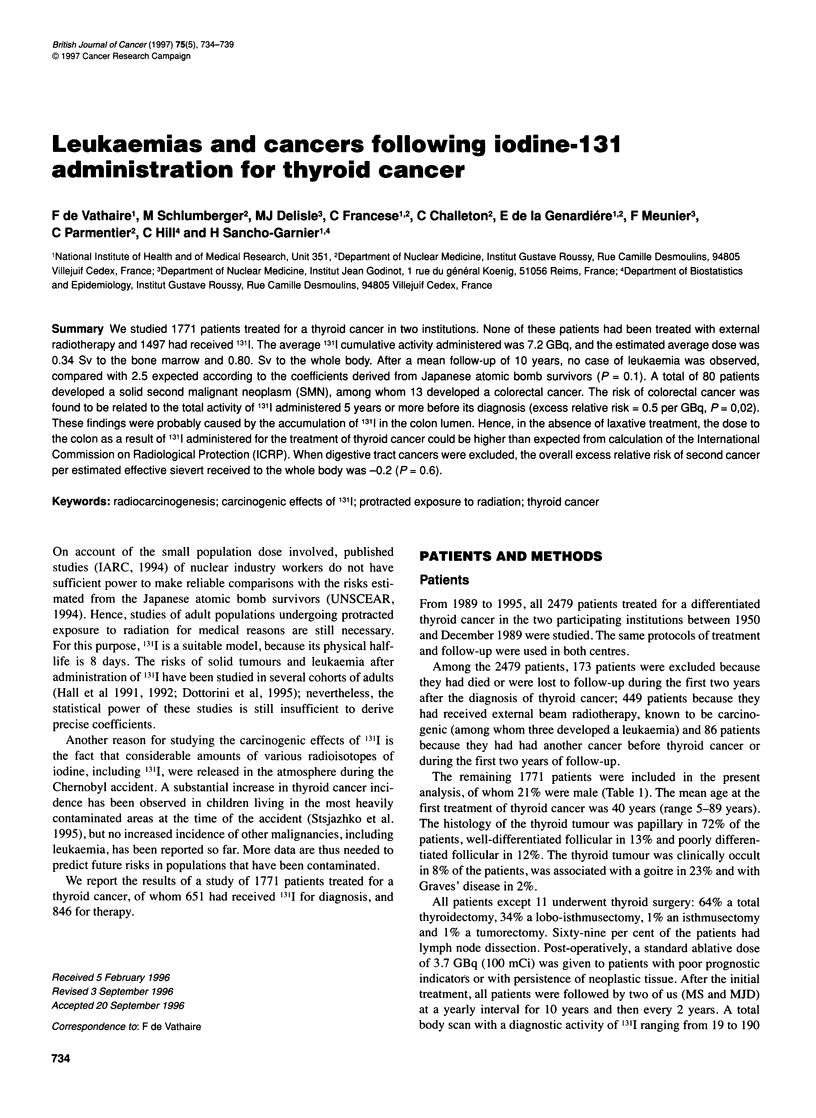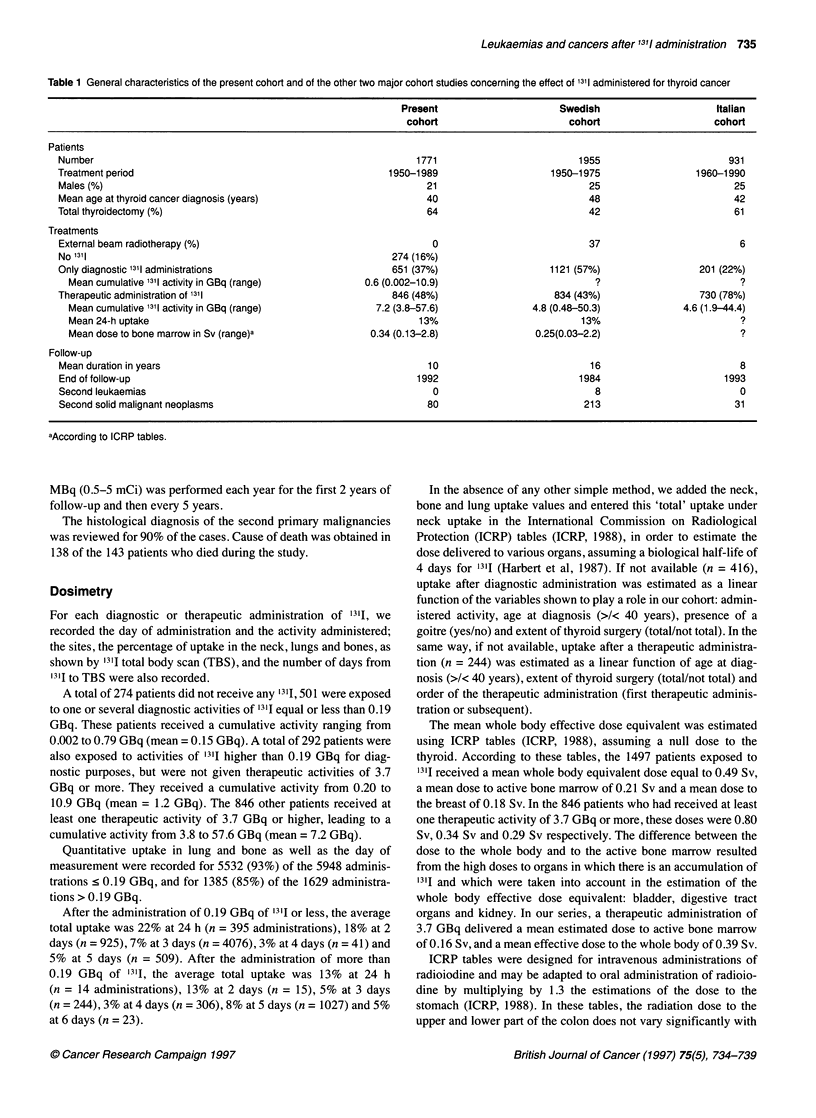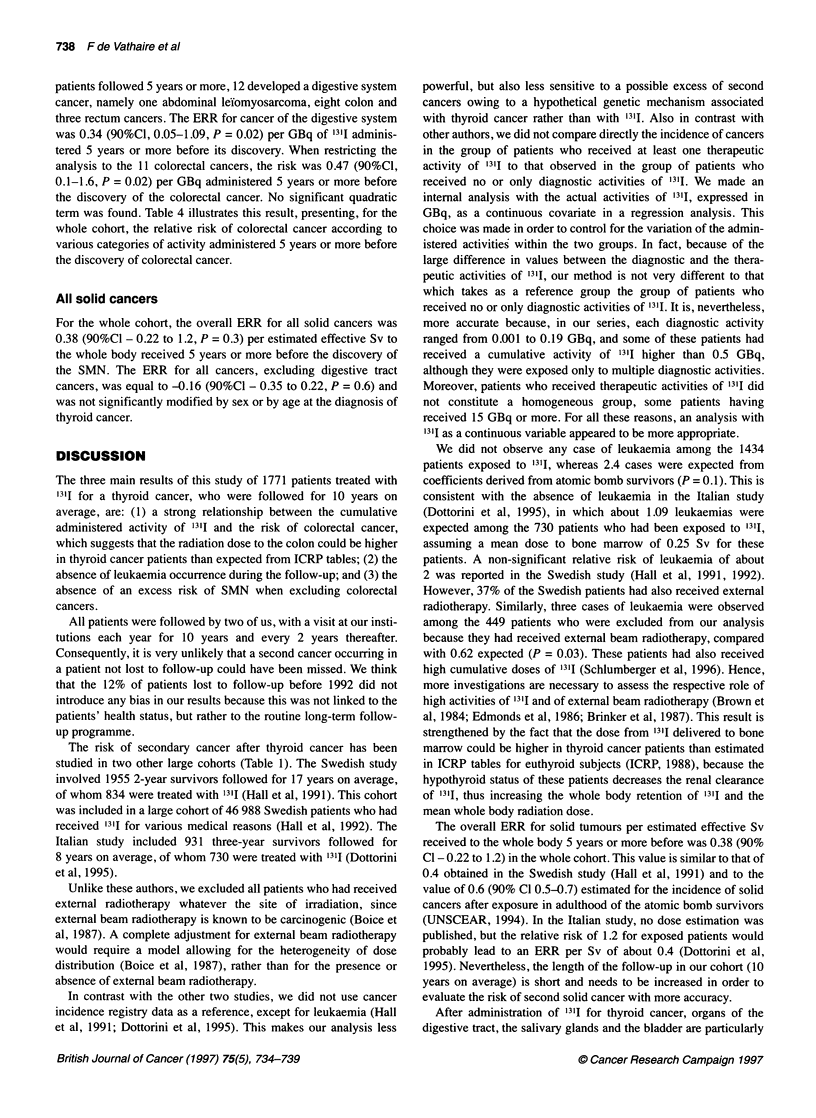Abstract
We studied 1771 patients treated for a thyroid cancer in two institutions. None of these patients had been treated with external radiotherapy and 1497 had received (131)I. The average (131)I cumulative activity administered was 7.2 GBq, and the estimated average dose was 0.34 Sv to the bone marrow and 0.80 Sv to the whole body. After a mean follow-up of 10 years, no case of leukaemia was observed, compared with 2.5 expected according to the coefficients derived from Japanese atomic bomb survivors (P = 0.1). A total of 80 patients developed a solid second malignant neoplasm (SMN), among whom 13 developed a colorectal cancer. The risk of colorectal cancer was found to be related to the total activity of (131)I administered 5 years or more before its diagnosis (excess relative risk = 0.5 per GBq, P = 0.02). These findings were probably caused by the accumulation of (131)I in the colon lumen. Hence, in the absence of laxative treatment, the dose to the colon as a result of (131)I administered for the treatment of thyroid cancer could be higher than expected from calculation of the International Commission on Radiological Protection (ICRP). When digestive tract cancers were excluded, the overall excess relative risk of second cancer per estimated effective sievert received to the whole body was -0.2 (P = 0.6).
Full text
PDF





Images in this article
Selected References
These references are in PubMed. This may not be the complete list of references from this article.
- Brincker H., Hansen H. S., Andersen A. P. Induction of leukemia by 131-I treatment of thyroid carcinoma. Br J Cancer. 1973 Sep;28(3):232–237. doi: 10.1038/bjc.1973.142. [DOI] [PMC free article] [PubMed] [Google Scholar]
- Brown A. P., Greening W. P., McCready V. R., Shaw H. J., Harmer C. L. Radioiodine treatment of metastatic thyroid carcinoma: the Royal Marsden Hospital experience. Br J Radiol. 1984 Apr;57(676):323–327. doi: 10.1259/0007-1285-57-676-323. [DOI] [PubMed] [Google Scholar]
- Dottorini M. E. Genetic risk assessment after iodine-131 exposure: an opportunity and obligation for nuclear medicine. J Nucl Med. 1996 Apr;37(4):612–615. [PubMed] [Google Scholar]
- Dottorini M. E., Lomuscio G., Mazzucchelli L., Vignati A., Colombo L. Assessment of female fertility and carcinogenesis after iodine-131 therapy for differentiated thyroid carcinoma. J Nucl Med. 1995 Jan;36(1):21–27. [PubMed] [Google Scholar]
- Edmonds C. J., Smith T. The long-term hazards of the treatment of thyroid cancer with radioiodine. Br J Radiol. 1986 Jan;59(697):45–51. doi: 10.1259/0007-1285-59-697-45. [DOI] [PubMed] [Google Scholar]
- Hall P., Boice J. D., Jr, Berg G., Bjelkengren G., Ericsson U. B., Hallquist A., Lidberg M., Lundell G., Mattsson A., Tennvall J. Leukaemia incidence after iodine-131 exposure. Lancet. 1992 Jul 4;340(8810):1–4. doi: 10.1016/0140-6736(92)92421-b. [DOI] [PubMed] [Google Scholar]
- Hall P., Holm L. E., Lundell G., Bjelkengren G., Larsson L. G., Lindberg S., Tennvall J., Wicklund H., Boice J. D., Jr Cancer risks in thyroid cancer patients. Br J Cancer. 1991 Jul;64(1):159–163. doi: 10.1038/bjc.1991.261. [DOI] [PMC free article] [PubMed] [Google Scholar]
- Stsjazhko V. A., Tsyb A. F., Tronko N. D., Souchkevitch G., Baverstock K. F. Childhood thyroid cancer since accident at Chernobyl. BMJ. 1995 Mar 25;310(6982):801–801. doi: 10.1136/bmj.310.6982.801. [DOI] [PMC free article] [PubMed] [Google Scholar]



